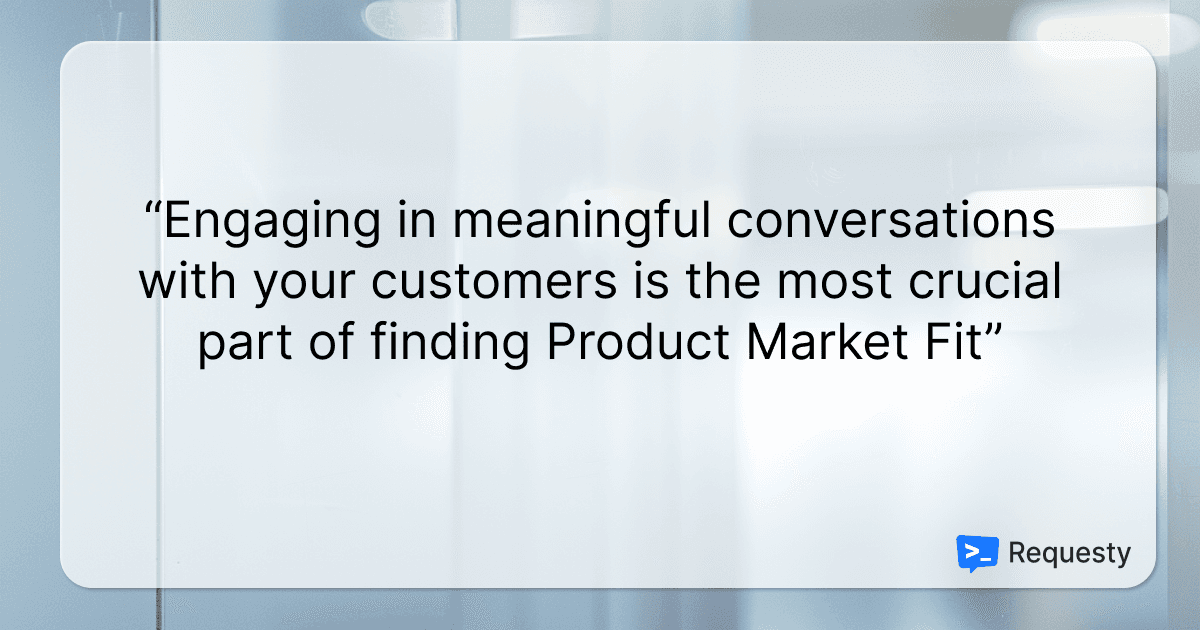Using Customer Conversations to Find Product-Market-Fit
Jul 16, 2024

Finding the right product-market fit is the dream and nightmare of everyone building product. There are many fresh methods such as Sequoia’s Arc framework and others, but it probably all started with Marc Andreessen’s blog ‘On product/market fit for startups’. His definition: “The customers are buying the product just as fast as you can make it -- or usage is growing just as fast as you can add more servers. Money from customers is piling up in your company checking account. You're hiring sales and customer support staff as fast as you can.” Sounds dreamy, doesn’t it!
Now, how do you get there? I’d argue that engaging in meaningful conversations with your customers is the most crucial part of that journey. Here's how to use customer feedback to refine your product and ensure it meets the market’s needs:
Understanding Product-Market Fit
Product-market fit means your product meets the needs of a specific market. That means identifying your target market, understanding their problems, and offering a solution that effectively addresses these problems.
Identify Your Target Market: Determine who will benefit most from your product.
Understand Their Problems: Learn about the challenges and pain points your target market faces.
Offer a Solution: Develop a product that effectively addresses these identified problems.
Why Customer Conversations Matter
Talking to your customers provides invaluable insights into their needs and experiences. This helps you understand what they like about your product, what needs improvement, and what additional features they desire. Engaging directly in such qualitative data gathering with your customers can reveal insights that click behaviour alone would miss.
Steps to Use Customer Conversations for Product-Market Fit
1. Identify Your Customers
Before diving into conversations, it's crucial to know who your customers are. Segment your audience into different groups based on demographics, behavior, and preferences. Focus on early adopters as they are usually more engaged and provide detailed feedback.
Segment Your Audience: Group your customers based on demographics, behavior, and preferences.
Focus on Early Adopters: These customers are more likely to provide detailed feedback as they are more invested in your product.
2. Engage in Direct Conversations
Direct conversations are the dowsing twig of understanding customer needs. For conversational insights, use a combination of interviews, focus groups, and support conversions. Surveys can also provide a broader perspective, combining targeted quantitative insights with qualitative feedback.
Interviews: Conduct one-on-one interviews to dive deeper into customer experiences.
Focus Groups: Organize focus groups to discuss the product with a small group of customers.
Support conversations: Provide less restricted feedback that is usually more honest and highlight how your product could be improved.
Surveys: For specific questions requiring guardrails for quantitative insights or qualitative feedback.
3. Ask the Right Questions
The quality of the feedback depends on the questions you ask. For useful feedback, ask questions that help you understand the customer's problems, how they use your product, and what improvements they suggest.
What problem does our product solve for you?
How does our product compare to others you have used?
What features do you find most valuable?
What improvements would you suggest?
4. Analyze the Feedback
After gathering feedback, the next step is analysis. Look for patterns and common themes to identify critical areas for improvement. Prioritize these issues based on their impact on the majority of your customers.
Look for Patterns: Identify common themes and recurring issues.
Prioritize Issues: Focus on the most critical feedback that affects the majority of your most relevant customers.
5. Implement Changes
Implement the changes based on the feedback. This might include improving existing features or adding new ones that customers have requested. Iterate on your product continually to ensure it remains aligned with customer needs.
Product Improvements: Make necessary changes based on the feedback.
Feature Additions: Consider adding new features that customers have requested.
Iterate: Continuously refine your product by repeating the feedback loop.
Common Questions About Product-Market Fit
What Support Conversations Are Useful for Product-Market Fit?
Support conversations that highlight recurring issues, feature requests, and user complaints are invaluable. Pay attention to the problems customers face, their suggestions for improvement, and their usage patterns.
What Questions Should I Ask for Product-Market Fit?
To gather useful feedback, consider asking:
What problem does our product solve for you?
How does our product compare to others you have used?
What features do you find most valuable?
What improvements would you suggest?
What Are the 4 Types of Product-Market Fit?
Problem-Solution Fit: Your product addresses a specific problem effectively.
Product-Market Segment Fit: The product meets the needs of a well-defined market segment.
Scaling Fit: The product, market and your channel are ready for scaling and broader adoption.
Business Model Fit: The business model is sustainable and aligns with market expectations.
How Do You Demonstrate Product-Market Fit?
You can demonstrate product-market fit through various indicators:
High customer retention rates
Positive customer feedback
Consistent sales growth
Strong market demand and interest
Benefits of Using Customer Conversations
Better Understanding of Customer Needs: Direct conversations help you understand what customers truly want.
Improved Customer Experience: Implementing feedback leads to a sense of being cared for and, eventually, a better product and higher customer satisfaction.
Increased Loyalty: When customers see that their feedback is valued, they are more likely to remain loyal.
Tips for Effective Customer Conversations
Be Open-Minded: Don’t dismiss negative feedback. It’s crucial for improvement.
Ask Follow-Up Questions: Dive deeper to get to the root of the issue.
Document Everything: Keep detailed records of all feedback for future reference.
Finding product-market fit is an ongoing process that requires continuous engagement with your customers. By leveraging customer conversations, you can gather the insights needed to refine your product, ensuring it meets the market’s needs and exceeds customer expectations. Using the conversations you have with your customers is the most truthful, accessible and insightful way to build towards PMF more quickly. Make sure to use that data until your customers are buying the product just as fast as you can make it (and maybe after that too).
Like our content? Interested in learning more? All our articles




